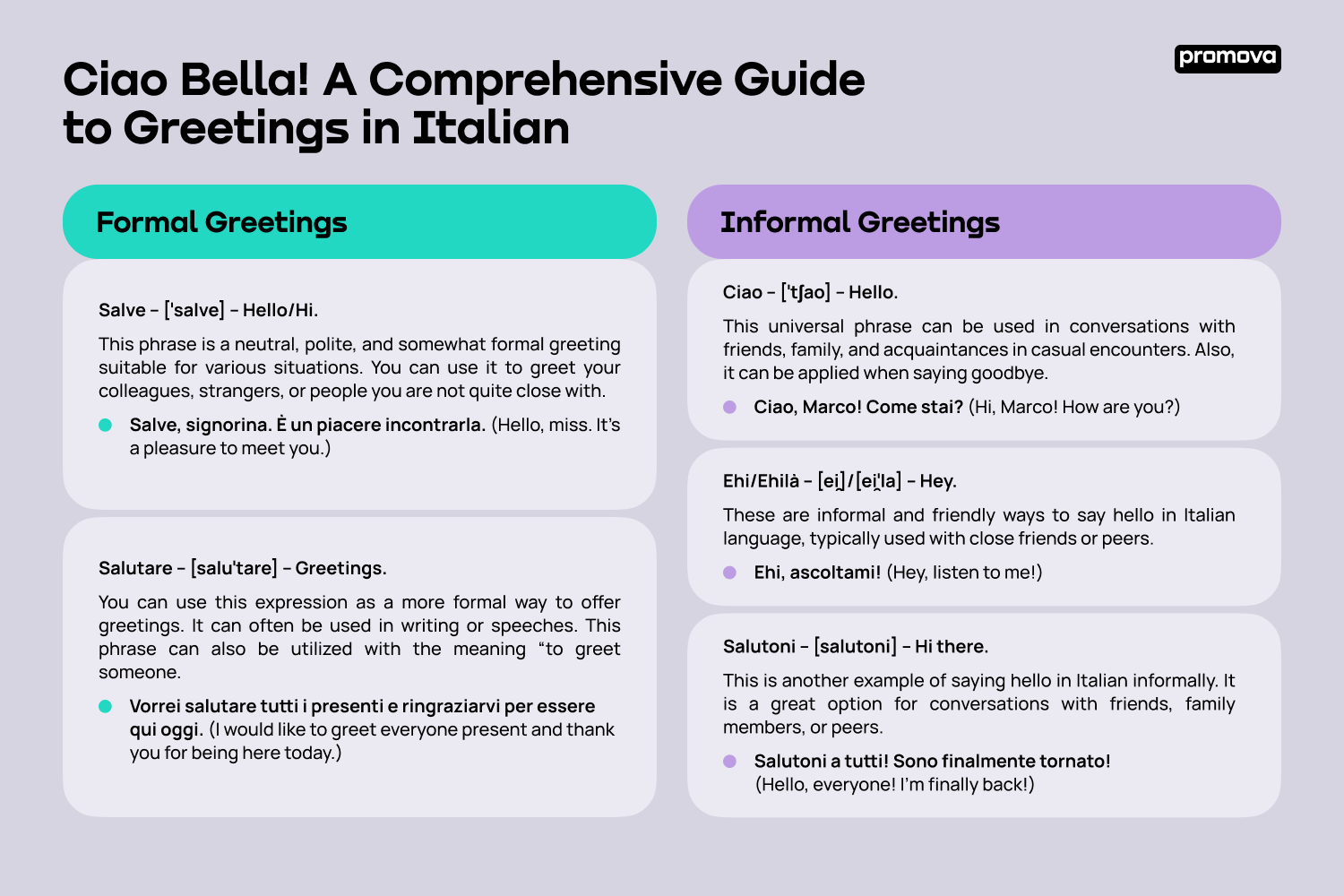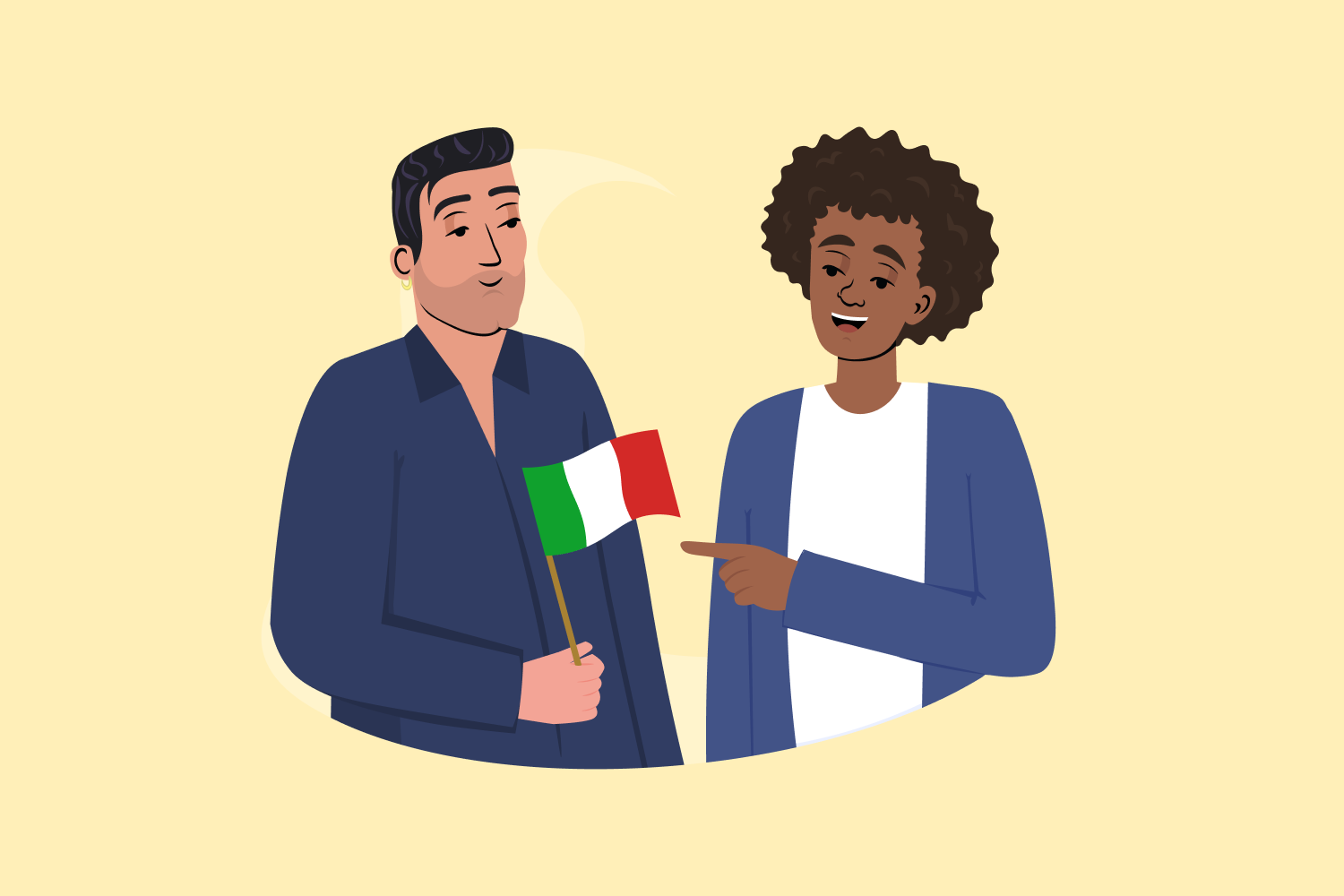Ciao Bella! A Comprehensive Guide to Greetings in Italian
Contenido
Italian people are known for being very affectionate and passionate, and these qualities are also present in their beautiful language. That is why even a simple word like hello in Italian can sound with various emotions, depending on circumstances. In today’s article, we’ll dive into the world of Italian greetings and explore the most widespread phrases and expressions for saying hello. So, without further ado, let’s begin!
Common Ways to Say Hi in Italian
The best way to communicate with locals in any country you intend to visit is by talking to them in their native language. And, of course, it doesn’t necessarily mean you should be a hundred percent fluent. Sometimes, it’s enough to learn some basic phrases and expressions. Therefore, let’s start simple – check out our extensive list of Italian greetings to begin any conversation.
Formal Greetings
While some Italian phrases can be used in both formal and informal conversations, there are situations when you should be more polite than usual. In this case, you can use some of the hello in Italian formal phrases provided below.
- Salve – [ˈsalve] – Hello/Hi.
This phrase is a neutral, polite, and somewhat formal greeting suitable for various situations. You can use it to greet your colleagues, strangers, or people you are not quite close with. For example:
Salve, signorina. È un piacere incontrarla. (Hello, miss. It’s a pleasure to meet you.)
Salve, caro amico. Come stai? (Hi, dear friend. How are you?)
Salve, tutti. Siete pronti per la riunione? (Hello, everyone. Are you ready for the meeting?)
- Salutare – [saluˈtare] – Greetings.
You can use this expression as a more formal way to offer greetings. It can often be used in writing or speeches. This phrase can also be utilized with the meaning “to greet someone.” For example:
Vorrei salutare tutti i presenti e ringraziarvi per essere qui oggi. (I would like to greet everyone present and thank you for being here today.)
In questo messaggio vorrei salutare i nostri clienti fedeli. (In this message, I would like to greet our loyal customers.)
Il sindaco ha inviato una lettera di saluto al presidente. (The mayor sent a greeting letter to the president.)
- Egregio/a – [eɡredʒo/a] – Dear, Respected.
The last formal greeting in Italian on our list is a polite salutation used in written communication when addressing someone with respect, often in professional or official contexts. For example:
Egregio Signor Rossi, Le scrivo per confermare l'appuntamento. (Dear Mr. Rossi, I am writing to confirm the appointment.)
Egregia Professoressa Bianchi, La ringrazio per la Sua lettera. (Respected Professor Bianchi, I thank you for your letter.)
Caro amico, Egregio Signor Smith, vorrei condividere alcune idee con Lei. (Dear friend, Respected Mr. Smith, I would like to share some ideas with you.)
Informal Greetings
The abovementioned phrases are great for professional settings, communication with colleagues, elderly people, etc. But if you want something more casual, like saying a simple hey in Italian, look at the expressions from this informal list.
- Ciao – [ˈtʃao] – Hello.
This universal phrase can be used in conversations with friends, family, and acquaintances in casual encounters. Also, it can be applied when saying goodbye. For example:
Ciao, Marco! Come stai? (Hi, Marco! How are you?)
Ciao a tutti! (Hello, everyone!)
Ciao, mamma! Sono a casa. (Hi, Mom! I’m home.)
- Ehi/Ehilà – [ei̯]/[ei̯ˈla] – Hey.
These are informal and friendly ways to say hello in Italian language, typically used with close friends or peers. For example:
Ehi, ascoltami! (Hey, listen to me!)
Ehilà, amico! Come va? (Hey there, friend! How’s it going?)
Ehi ragazzi, che ne dite di uscire stasera? (Hey guys, what do you say we go out tonight?)
- Ciao bella/Ciao bello – [ˈtʃao ˈbɛlla]/[ˈtʃao ˈbɛllo] – Hello, beautiful.
Use these informal greetings among close friends or when flirting with someone. For example:
Ciao bella! Ti ho pensata tutto il giorno. (Hi there, beautiful! I’ve been thinking about you all day.)
Ciao bello, hai un aspetto fantastico oggi! (Hey, handsome, you look fantastic today!)
Ciao bella, come è andata la tua giornata? (Hi lovely, how was your day?)
- Salutoni – [salutoni] – Hi there.
This is another example of saying hello in Italian informally. It is a great option for conversations with friends, family members, or peers. For example:
Salutoni a tutti! Sono finalmente tornato! (Hello, everyone! I’m finally back!)
Salutoni, amica mia! Da quanto tempo non ci vedevamo! (Hey there, my friend! It’s been so long since we last saw each other!)
Salutoni ragazzi, cosa avete fatto di interessante oggi? (Hey guys, what interesting things have you done today?)
- Ecco mi/Eccomi – [ekˈkomi] – Here I am.
These informal greetings should be your go-to choice when you want to announce your presence. For example:
Ecco mi, sono arrivato! Cosa state facendo? (Here I am, I’ve arrived! What are you all doing?)
Eccomi, finalmente ho trovato il parcheggio! (Here I am, I finally found a parking spot!)
Ecco mi ragazzi, pronto per la serata! (Hey there, everyone! I’m here and ready for the evening!)

Italian Greetings for Different Parts of the Day
Sometimes, the way you greet someone depends on the time you are talking to them. For example, you won’t say “good morning” after midnight. In this case, you can use special expressions suitable for different parts of the day. You can find them in this comprehensive list.
- Buongiorno – [bwonˈdʒorno] – Good morning.
Buongiorno, sole! È una bellissima giornata! (Good morning, sun! It’s a beautiful day!)
Buongiorno a tutti! Spero che abbiate dormito bene. (Good morning, everyone! I hope you slept well.)
Buongiorno, caro. Cosa hai in programma per oggi? (Good morning, dear. What do you have planned for today?)
- Buon pomeriggio – [ˈbwɔm pomeˈriddʒo] – Good afternoon.
Buon pomeriggio, amici! Come state trascorrendo il vostro giorno? (Good afternoon, friends! How are you spending your day?)
Buon pomeriggio, signora. La vista da qui è spettacolare. (Good afternoon, ma’am. The view from here is spectacular.)
Buon pomeriggio, colleghi. Abbiamo una riunione alle 3. (Good afternoon, colleagues. We have a meeting at 3.)
- Buonasera – [bwonaˈzera] – Good evening.
Buonasera, cari. Cosa c’è di buono per cena stasera? (Good evening, dear. What’s for dinner tonight?)
Buonasera a tutti! Spero abbiate trascorso una giornata meravigliosa. (Good evening, everyone! I hope you had a wonderful day.)
Buonasera, dottore. Come procede la giornata in ospedale? (Good evening, doctor. How’s the day at the hospital going?)
- Buona notte – [ˈbwɔna ˈnɔtte] – Good night.
Buona notte, ragazzi. Sognate a occhi aperti! (Good night, guys. Dream with your eyes open!)
Buona notte, amore. Dormi bene e sognami. (Good night, my love. Sleep well and dream of me.)
Buona notte, mamma e papà. Grazie per tutto. (Good night, Mom and Dad. Thank you for everything.)
Saying Hi in Italian: Unique Greetings for Special Occasions
There are some situations when greeting a person goes beyond simple “hello.” Usually, it happens on special days and events, like holidays or important milestones. In this case, you can use unique phrases to celebrate the occasion and start the conversation at the same time. Here are the most common examples of such greetings in Italian:
- Buon Natale – [ˈbwɔn naˈtale] – Merry Christmas.
- Buon Anno – [ˈbwɔn ˈanno] – Happy New Year.
- Buon Compleanno – [ˈbwɔn kompleˈanno] – Happy Birthday.
- Buona Pasqua – [ˈbwɔna ˈpaskwa] – Happy Easter.
- Felice Anniversario – [feˈlitʃe anniverˈsarjo] – Happy Anniversary.
These unique Italian greetings for special occasions add a touch of warmth and celebration to important moments in life, from holidays to birthdays and anniversaries. Of course, they can’t be used every day, but it may still be useful to know some of them to be prepared for various circumstances.
11
Learning How to Say Hello in Italian with Promova
Studying a foreign language sometimes requires looking for additional resources. To save you time, we would like to introduce you to the Promova app – your one-stop solution for learning languages anywhere and anytime you want. This convenient application provides numerous advantages for those aiming to master speaking, reading, and listening skills in Italian, Spanish, French, Korean, German, and other tongues.
The Promova app allows you to study with a convenient bite-sized methodology that requires only 10–15 minutes daily. Our user-friendly design and interactive lessons make your studying process engaging and captivating. You can also track your progress within the application, which allows you to stay motivated and monitor your results and achievements.
All the lessons available in the Promova app were created by language experts, making them useful for learners of different levels. And the best thing is that you can access them anytime you want, using only your phone or tablet. Promova application is a great tool for those who want to master a new language or improve previously gained skills. With a bit of effort and consistency, you’ll receive the desired results very soon.
Conclusion
To sum up, we can say that Italian greetings are as diverse and exciting as the country’s culture in general. Whether you’re preparing for a trip, building connections with Italian-speaking friends, or simply exploring the intricacies of language, may the phrases from today’s article open doors to wonderful conversations and memorable experiences. And that’s it for now. Ciao!
FAQ
Are there Italian equivalents of informal phrases like “What’s up?” that can be used as a greeting?
Yes, Italians have informal greetings similar to this English expression. One common phrase is “Come va?” which translates to “How’s it going?” or “What’s up?” This is a casual way to ask someone about their well-being or to start a conversation informally. Another informal greeting is “Che fai?” or “Cosa fai?” which means “What are you doing?” These phrases are suitable for interactions among friends and acquaintances.
Do Italians appreciate it when foreigners use greetings in their language?
Yes, Italian people generally appreciate it when foreigners make an effort to use greetings in their language. It shows respect for the local culture and can help create a more positive and welcoming interaction. Using Italian greetings, even if it’s just a simple “Ciao” or “Buongiorno,” can be a great way to break the ice and connect with locals while traveling in Italy.
Are Italian greetings the first thing I should learn to improve my communication skills?
Sure, these phrases should be among the first things to learn for effective communication. However, it’s also important to master some fundamental expressions for everyday situations, such as introducing yourself, asking for directions, or ordering food. Learning basic conversational phrases will improve your overall communication skills and make your interactions smoother.
Is it essential to use gestures when greeting someone in Italy?
Although Italian people are known for their expressive gesturing, it doesn’t mean you should do the same thing when communicating with them. While some gestures, like handshakes, can be appropriate in certain situations, it is essential to respect the boundaries of your interlocutors and be respectful. Meanwhile, using appropriate gestures can enhance your interactions in Italy and convey enthusiasm and friendliness.

Comentarios